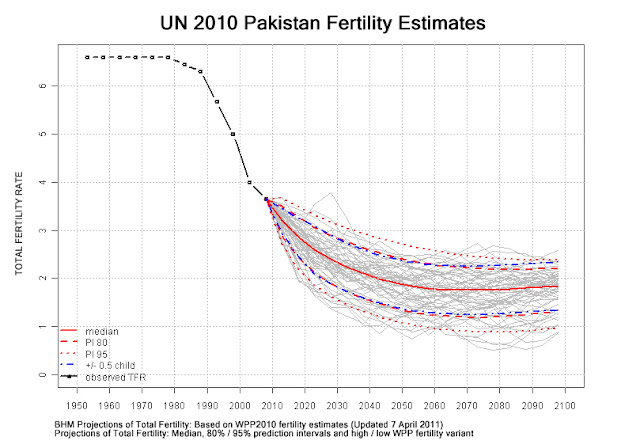What is going on over at the UN Population Division? In response to
The New Security Beat’s post on the
UN’s sub-Saharan projections, Ed Carr of USAID
recently highlighted what appears to be gross overestimations in the 2010 population revision for Ghana. Yet in the case of Pakistan, the opposite is seemingly at play – the projections appear to wildly (and unrealistically) underestimate population numbers for the coming decades.
The 2008 revision’s mid-variant estimate for Pakistan in 2050 was 335 million people. The new revision projects only about 275 million by that year. Even the new high-variant estimate (314 million) falls below the earlier mid-variant projection. Furthermore, the constant-fertility variant estimate for 2050 has fallen from 450 million to under 380 million.
What gives? Thanks to some helpful staff at the Population Division and Population Action International’s Elizabeth Leahy Madsen (who helped translate the UN’s demographic-ese for this non-specialist), I can only conclude that the UN has decided to hedge its bets that Pakistan’s fertility rates will fall, simply because its South Asian neighbors (and other nations) have followed this trajectory.
If so, I believe this assumption is spurious. As reported in the Wilson Center’s recent book on Pakistan’s population challenges, though Pakistan’s fertility rate is in decline, it is falling at a considerably slower pace than that of its neighbors, and the rate of decrease has slowed considerably over the last decade. The country’s total fertility rate (TFR) today is just under four, considerably above the replacement level rate (2.1).
By many indications, Pakistan’s TFR does not figure to fall quickly anytime soon. Pakistan’s maternal and reproductive health sector is deeply troubled, with family planning services either of poor quality or nonexistent – particularly in rural areas. Many rural women are obliged to travel on average 50 to 100 kilometers to obtain such services. Meanwhile, the status of Pakistani women is dreadful; female literacy is estimated to stand at only 44 percent (some places it as low as 35 percent), while women’s labor participation rates barely approach 20 percent. Not surprisingly, Pakistan’s contraceptive prevalence rate is quite low (30 percent), while its rate of unmet need for family planning is high (25 percent).
With all of Pakistan’s problems, improving access to family planning is simply not a front-burner issue for Islamabad (in fact, as our book notes, demography on the whole is largely neglected in Pakistan), which makes the 2010 revision’s projections all the more questionable.
The UN is expected to release details on the methodology behind its basic assumptions in the coming weeks; here’s hoping for some clarity. (Editor’s note: As Liz Madsen points out, there’s also a white paper on the new probabilistic model to sift through, if you’re prepared for some heavy reading.)
Michael Kugelman is a program associate for the Asia Program at the Woodrow Wilson Center.
Chart Credit: Modification of projections of total fertility based on Bayesian hierarchical model, courtesy of the UN Population Division.
 A Publication of the Stimson Center.
A Publication of the Stimson Center.




